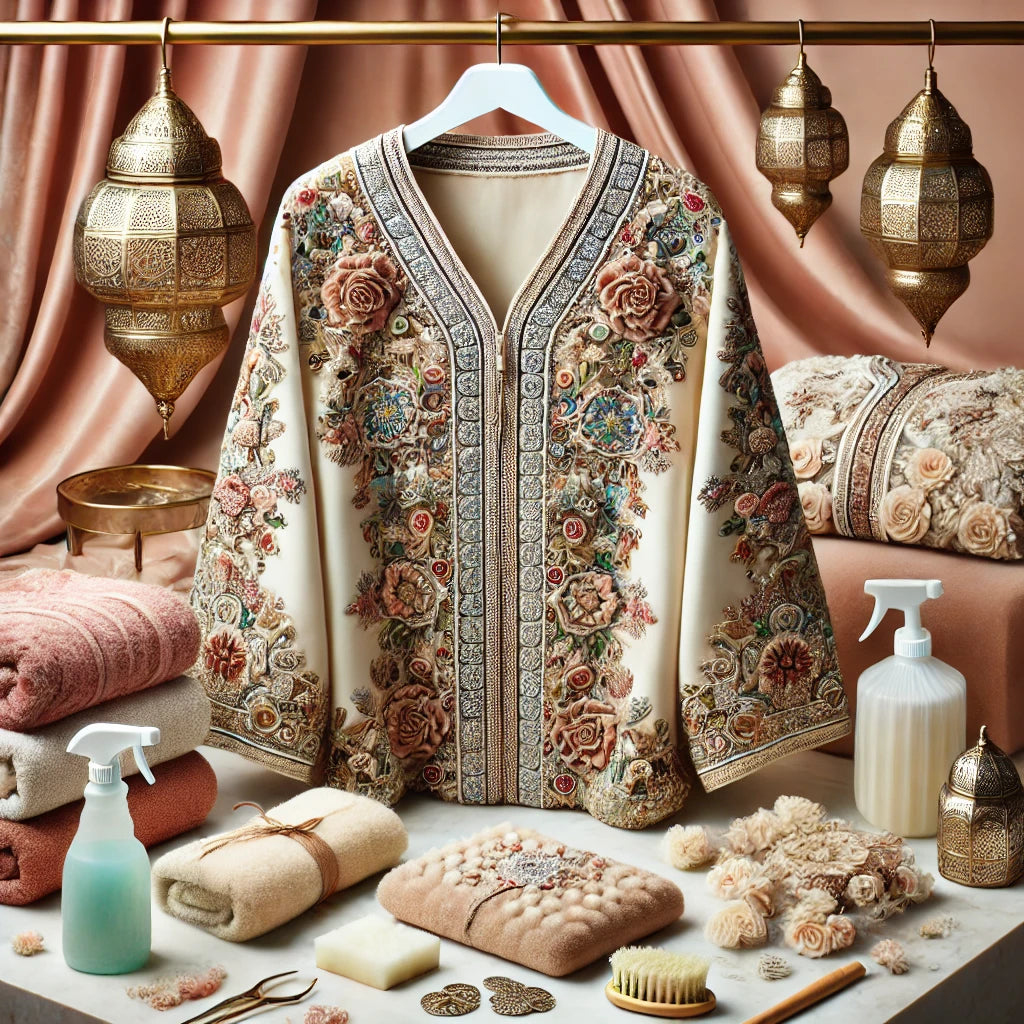A Fashion Treasure: The Caftan and How to Care for It
The Moroccan caftan, Morocco's iconic garment, is a symbol of femininity, culture, and elegance. With its sumptuous patterns, refined fabrics, and majestic cuts, it has won the hearts of many women around the world. This traditional garment, once reserved for royal ceremonies, has become a staple in modern wardrobes. Yet, behind its luxurious appearance, the caftan requires special care, especially when it comes to its maintenance. You've probably wondered how to wash a caftan without damaging its delicate details and embellishments. This article will guide you through the essential steps for caring for this precious piece, while also giving you some tips to keep it as radiant as the first day.
Imagine yourself wearing a magnificent gold-embroidered caftan at an elegant party. You receive compliments from every corner of the room, everyone admiring the beauty of your outfit. But after such an evening, what can you do to preserve this splendor? How to wash a caftan without compromising its beauty and elegance? This is a question many women ask themselves, and for good reason: a well-maintained caftan can last for years, remaining as radiant as the day you bought it.
In this article, we offer simple, practical advice tailored to all women who are concerned about preserving their caftan, whether it is silk, embroidered, or adorned with precious stones. We will also reveal some well-kept secrets to ensure your caftan always remains impeccable. Whether you are a regular user of Moroccan caftans or have just acquired one for the first time, you will learn everything you need to know to pamper it properly. And for those looking to expand their collection, don't forget to take a look at our exclusive " Moroccan Caftan " collection , where each piece tells a unique story.
I. Precautions to Take Before Washing a Caftan
Before you even think about washing your caftan, it's crucial to know some precautions to preserve its refined details. The caftan, with its delicate embroidery, shimmering beads, and fine fabrics, is no ordinary garment. It requires special care, as a simple, poorly executed wash can ruin its embellishments or alter its colors.
1. Know the Fabrics of Your Caftan
Not all caftans are made from the same materials. Some are made of silk, others are made of satin or velvet. Each of these fabrics reacts differently to water and detergents. For example, silk is extremely sensitive to hot water, while velvet can lose its shine if washed too aggressively. Take Amina, for example, who, after wearing her silk caftan to a ceremony, decided to wash it without paying attention to the label. The result? Misshapen silk and faded colors.
To avoid this kind of mishap, always read the washing instructions on the label of your caftan carefully before cleaning it. If you are unsure about the method to use, it is best to consult a professional dry cleaner.
Discover our " Moroccan Caftan " collection , where each model is made with quality fabrics, easy to maintain.
2. Avoid the Washing Machine: Hand Washing is Better
A caftan is far too precious to be thrown into a washing machine. Even on a gentle cycle, the machine's rough movements can damage the embroidery and beading. The best method for washing a caftan is still hand washing it in cold or warm water with a mild detergent. Zahra, a young bride, made the unfortunate decision to put her wedding caftan in the washing machine. As a result, her gold thread embroidery was torn out, and her dress lost all its shine.
Consider taking a look at our exclusive " Moroccan Caftan " collection for easy-care pieces.
3. Use a Gentle Detergent
A detergent that's too harsh can damage the fibers of your caftan. When washing a caftan , always choose a mild soap, free from harsh chemicals and bleaching agents. Opt for detergents specially formulated for delicate fabrics. A concrete example: Fatima, who regularly wears caftans for family events, noticed that her dress retained its shine and luster thanks to a mild detergent specially formulated for delicate fabrics.
Explore our "Moroccan Caftan" collection , where each model is designed to last with proper care.
II. Drying Techniques to Preserve the Beauty of Your Caftan
Once your caftan is washed, it's equally important to know how to dry it properly. Improper drying can alter the garment's shape, distort embroidery, or even cause unwanted wrinkles that will be difficult to remove later.
1. Gentle Spin
When you're finished washing your caftan , it's important not to wring it out like you would a regular garment. Wringing or squeezing too hard can damage the embroidery and embellishments. The best technique is to gently squeeze the fabric between two towels to remove excess water. This is what Leila did with her hand-embroidered silk caftan. Using this gentle method, she was able to preserve the integrity of the embroidery and the original shape of her dress.
Browse our " Moroccan Caftan " collection and find designs that combine beauty and durability.
2. Avoid the Dryer: Prefer Air Drying
The dryer is your caftan's worst enemy. Excessive heat can shrink the fabric, distort the fit, and fade the colors. To dry your caftan, lay it flat on a clean surface, preferably in the shade. The sun can also fade colors, especially for brightly colored caftans.
Rania accidentally dried her kaftan in direct sunlight, and the vibrant colors faded. Fortunately, she learned proper drying practices in time and avoided repeating this mistake with her other kaftans.
Don't miss our " Moroccan Caftan " collection , where each piece is designed to last with proper care.
3. Delicate Ironing
Ironing your caftan should also be done with care. Always use a pressing cloth to avoid direct contact with embroidery or delicate fabrics. An iron that's too hot could burn or mark the fabric. Imane, a kaftan enthusiast, discovered that using a low-temperature iron and a pressing cloth kept her dresses looking their best without damaging them.
Discover our " Moroccan Caftan " collection and find the perfect caftan for every occasion.
These tips will help you keep your caftans in pristine condition. Proper care is key to enjoying these traditional garments for many years to come. Pay careful attention to materials, washing, and drying techniques to preserve their natural beauty.
III. Prevent Stains and Repair Minor Damage
Kaftans, especially those adorned with embroidery and precious stones, are often worn on special occasions where accidents and stains can occur. Even if you're careful, a spilled glass of tea or an oil stain can quickly become a source of stress. But don't worry, there are effective solutions to prevent and repair these minor inconveniences.
1. Protect the Caftan before Wearing it
Before donning your kaftan for a special event, consider protecting it with a waterproofing spray for delicate fabrics. These sprays create an invisible barrier that prevents stains from setting into the fabric. Take Sarah, for example, who sprayed her kaftan with a protective spray before a wedding. Despite a small coffee spill, her kaftan remained intact because the stain was unable to penetrate the fabric.
Don't forget to discover our " Moroccan Caftan " collection , with elegant models for every special occasion.
2. Treat Stains Immediately
If a stain does occur, the key is to treat it immediately. Here's a quick tip: apply a mixture of cold water and mild soap to the stain with a clean cloth, dabbing gently without rubbing. For example, Yasmine, at a family party, managed to remove a sauce stain using this quick method, saving her precious caftan.
To avoid any stress related to stains, opt for our models from the " Moroccan Caftan " collection , created with easy-to-maintain materials.
3. Repair Damaged Embroidery and Beads
The delicate embellishments on your caftan can sometimes become loose or damaged over time, especially if you wear it often. But all is not lost! Many tailors specializing in traditional Moroccan clothing can repair embroidery or sew on missing beads. Fashion enthusiast Imane had her favorite caftan repaired after a bead came loose at an event. The caftan looked like new after this small repair.
Browse our " Moroccan Caftan " collection to discover timeless designs that you can wear proudly for many years to come.
IV. Storing and Preserving Your Caftan
When you're not wearing your caftan, proper storage is essential to preserve its beauty and shape. Caftans are often large pieces with intricate details that require special care when storing them. When properly stored, a caftan can remain in excellent condition and ready to wear at any time.
1. Hanging or Folding: Which is Better?
To prevent your kaftan from wrinkling or damaging the embroidery, it's best to hang it on a padded hanger. However, some kaftans, especially those made of heavy fabrics like velvet, can warp under their own weight if hung for too long. For these, gently folding with tissue paper between the layers is recommended.
For example, Nadia found that her velvet caftan held its shape better when she folded it neatly and stored it in a protective cover, rather than hanging it up.
Discover our “ Moroccan Caftan ” collection , where each piece is designed to stand the test of time.
2. Protect from moths and humidity
Like any precious garment, the caftan must be protected from moths and moisture, which can damage fine and delicate fabrics. Use lavender or cedar sachets in your closet to keep pests away, while ensuring the storage space is well ventilated. A telling example is Samira, who unfortunately discovered that moths had attacked the embroidery of her caftan. She has since taken to keeping cedar sachets in her wardrobe, and her caftans have remained intact ever since.
Don't miss our " Moroccan Caftan " collection , pieces to cherish and protect for many years.
3. Store in a Protective Cover
The kaftan should be stored in a breathable protective cover, ideal for protecting it from dust while allowing air to circulate. Plastic covers should be avoided, as they can trap moisture and damage delicate fabrics. Khadija, a major kaftan collector, invested in cotton covers to protect her collectibles, and she has never had any problems with moisture or discoloration.
To keep your caftan in the best condition, consider exploring our " Moroccan Caftan " collection and choose your next fashion treasure.
Conclusion
Caring for your caftan extends the magic and beauty of this traditional garment, preserving its vibrancy for many occasions to come. From washing methods to storage, every step counts to preserve the details that make each caftan unique. Whether your caftan is made of silk, velvet, or embroidered, these tips will help you keep it in perfect condition.
So, now that you know how to wash a caftan , why not enrich your collection with an exclusive piece from our " Moroccan Caftan " collection ? Let yourself be seduced by timeless elegance and Moroccan craftsmanship, and wear a caftan that tells your story.



Leave a comment
This site is protected by hCaptcha and the hCaptcha Privacy Policy and Terms of Service apply.